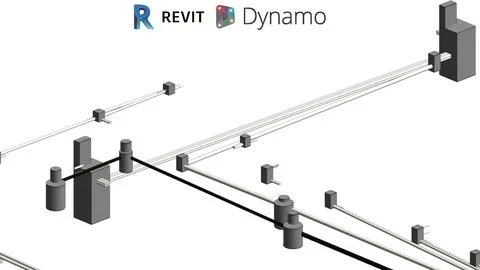Revit Dynamo Mep Modeling For Existing Conditions
Modeling with Data and Dynamo Existing Conditions of elements, MEP Instalations and Site Requirements.
What you'll learn
Develop some sample scripts to be follow by dynamo.
Learn to recognize patterns and protocols where as they need to be dynamo driven or dynamo player solved
Review relations and interactions of the content display with Dynamo and Revit.
Develop some sample scripts to be follow by dynamo.
Learn to recognize patterns and protocols where as they need to be dynamo driven or dynamo player solved
Review relations and interactions of the content display with Dynamo and Revit.

Requirements
A Computer to accomplish the recommended exercises
Need to install a trial of Autodesk Revit 2019 , and Dynamo 2.1 on the Computer
Need to know or have taken Dynamo Analysis and Dynamo Player Volume 1
Need to know how to model in Revit MEP Instalations
Description
This course it’s designed to help you reach modeling of existing conditions faster and cleaner than ever before on the unknown terrain of existing site conditions.
Most of the times a lot of elements where built on site with out clear set up of location and quite different from plans, so the only way to create their existing conditions its to get the complete values of their register settings, and assume by location that those values would certainly connect.
With Dynamo and Dynamo player we can create a complete set of elements created just for data, opening the possibility of Model creation by numerical controls, and also integrating better on future circumstances to Generative Design.Its an incredible opportunity to get access to workflows and open your possibilities to speed up your processes as well as for your partners or coworkers.
BIM is now on a second digital revolution where communication skills and programming would create a different value to construction and infrastructure BIM projects, the core stream would be reflected in responses and computer analysis rather than handmade models.
This course its part of a series of MEP modeling with Dynamo Series that clearly would become a complete collection of tools that can change modeling processes.On this course we will ground concepts for a practical use so we can communicate with the computer and its capabilities would reflect those results.
Communication is the core competence require for a fluent BIM Coordination, and I do believe that generative design would shorten and improve the BIM adoption rate on design processes, so we are talking on a quantum leap to coordinate with construction and engineering systems.
This course complements with other courses such as Dynamo Basic Modeling, Mastering Geometry with Dynamo, and it will also set a new requirement for future courses with other workflows.
Go at your own pace, jump between sections and enjoy a lifetime access of content Also, we have a direct response for any topic listed, so we can improve the content.Be the first to know of future courses regarding BIM, take advantage of all the opportunities that may appear and use it to improve your work performance and get better job positions.
Overview
Section 1: Introduction
Lecture 1 Introduction
Lecture 2 Modeling from Dynamo
Lecture 3 Resources
Section 2: Creating a Universal Family for Registers
Lecture 4 Universal Register Creation Method
Lecture 5 Creating Manhole Covers
Lecture 6 Creating Inner Chamber
Lecture 7 Creating Final Chamber Circular
Lecture 8 Creating Final Chamber Adjustments
Section 3: Creating Basic MEP Modeling
Lecture 9 Creating Pipes from File Data
Lecture 10 Creating Registers from File Data and Parameters
Section 4: Creating the MEP Model with Multiple Pipes and Connectors
Lecture 11 Configuring Family for Connectors Part A
Lecture 12 Configuring Family With Connectors Part B
Lecture 13 Creating Registers from File With Connectors
Lecture 14 Setting Connector Properties
Section 3: Creating Basic MEP Modeling
Lecture 9 Creating Pipes from File Data
Lecture 10 Creating Registers from File Data and Parameters
Section 4: Creating the MEP Model with Multiple Pipes and Connectors
Lecture 11 Configuring Family for Connectors Part A
Lecture 12 Configuring Family With Connectors Part B
Lecture 13 Creating Registers from File With Connectors
Lecture 14 Setting Connector Properties
Lecture 15 Exporting Connector Multiple Requirements
Lecture 16 Creating Related Pipes From Connectors
Lecture 17 Creating Multiple Related Pipes
Lecture 18 Creating Matrix Related Pipes
Lecture 19 Configuring Everything to have the info on CSV
Lecture 20 Creating Pipes From File
Lecture 21 Creating Related Pipes
Lecture 16 Creating Related Pipes From Connectors
Lecture 17 Creating Multiple Related Pipes
Lecture 18 Creating Matrix Related Pipes
Lecture 19 Configuring Everything to have the info on CSV
Lecture 20 Creating Pipes From File
Lecture 21 Creating Related Pipes
Designers, Architects and Engineers that need to model from existing conditions without plans,Land Developers that what to have overview of site components to propose new projects,BIM Managers and Coordinators that need existing models to get clash detection of elements.
Last updated 7/2019
MP4 | Video: h264, 1280x720 | Audio: AAC, 44.1 KHz
Language: English | Size: 1.94 GB | Duration: 3h 0m
Download
MP4 | Video: h264, 1280x720 | Audio: AAC, 44.1 KHz
Language: English | Size: 1.94 GB | Duration: 3h 0m
Download